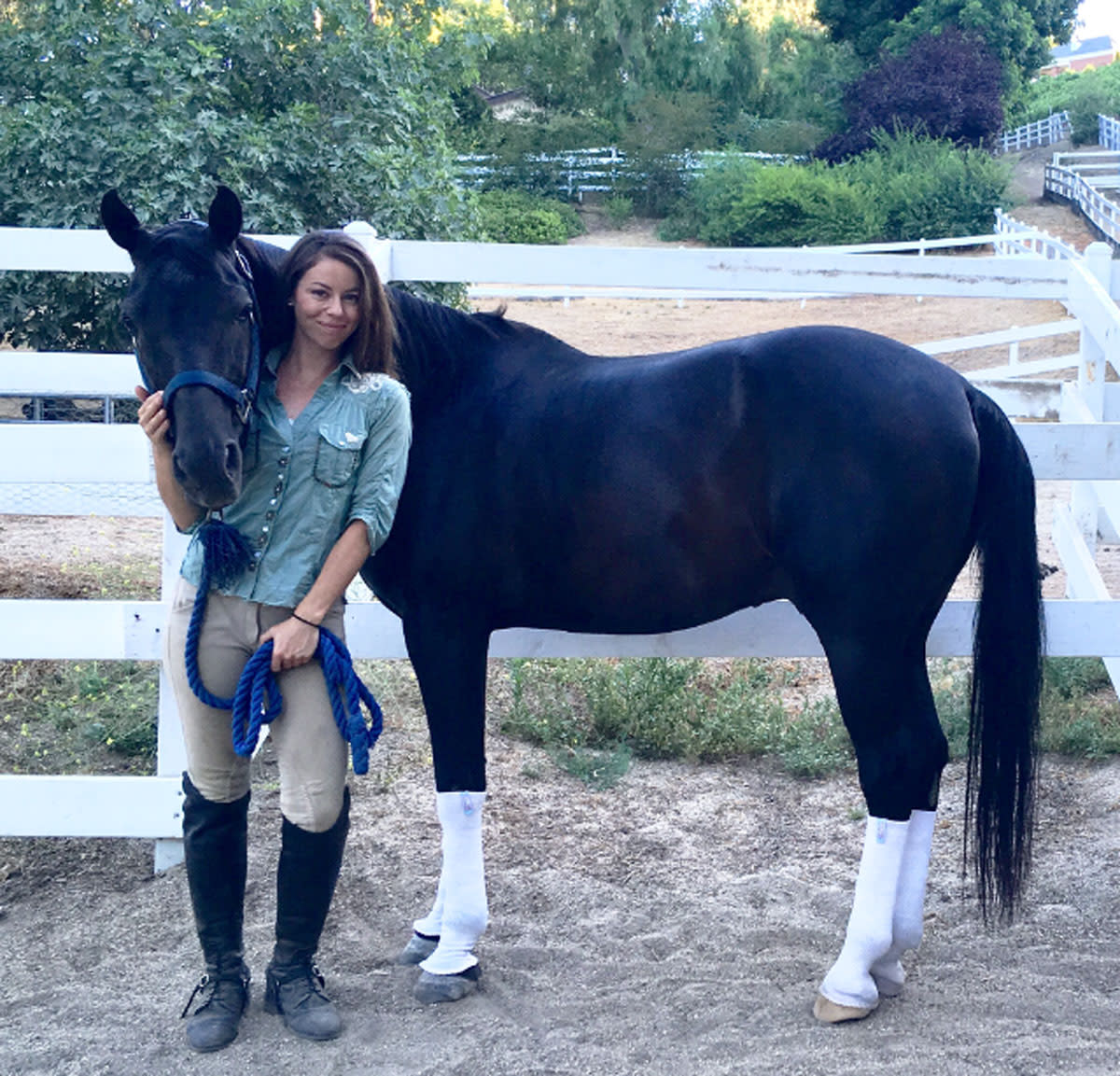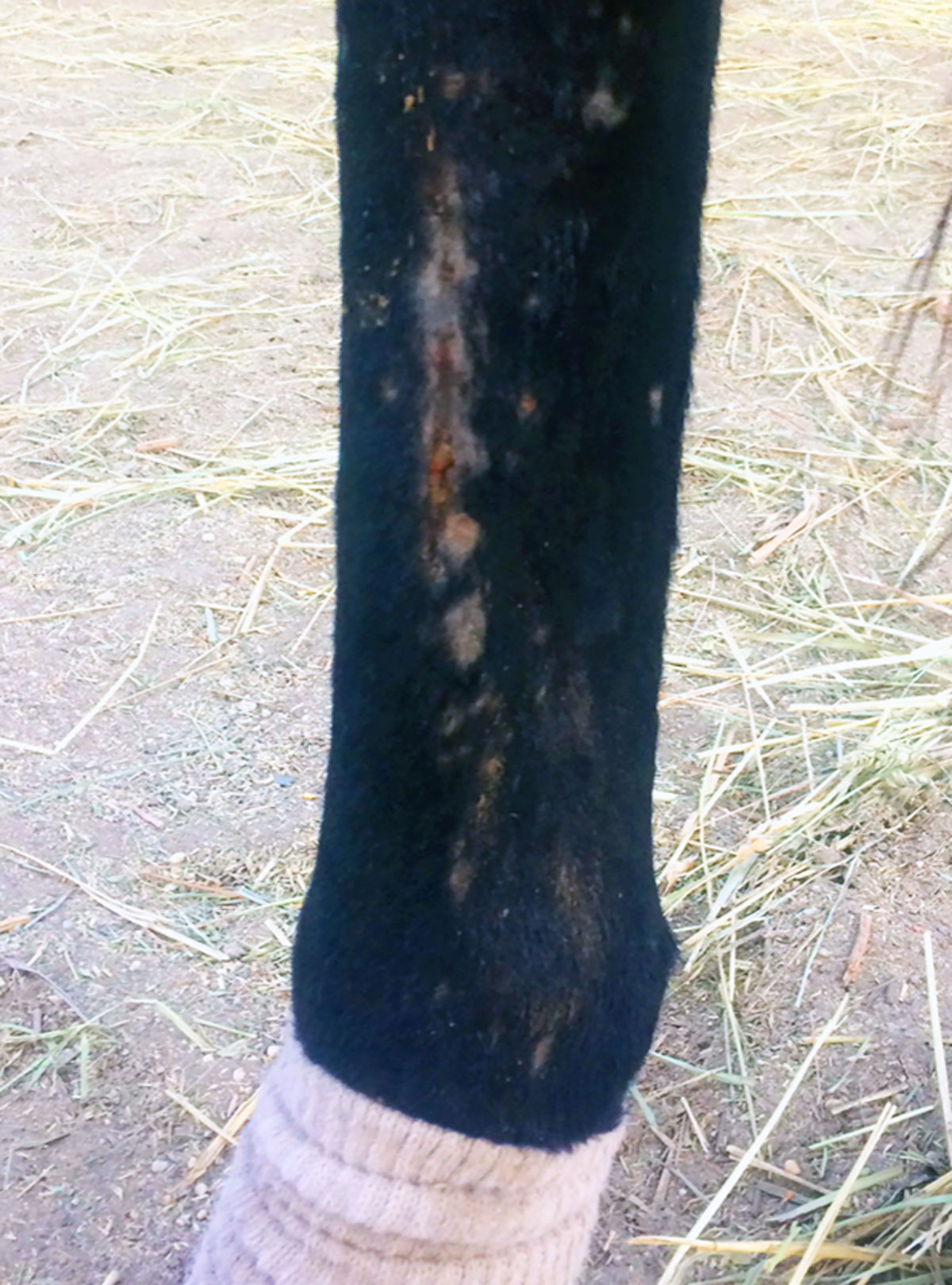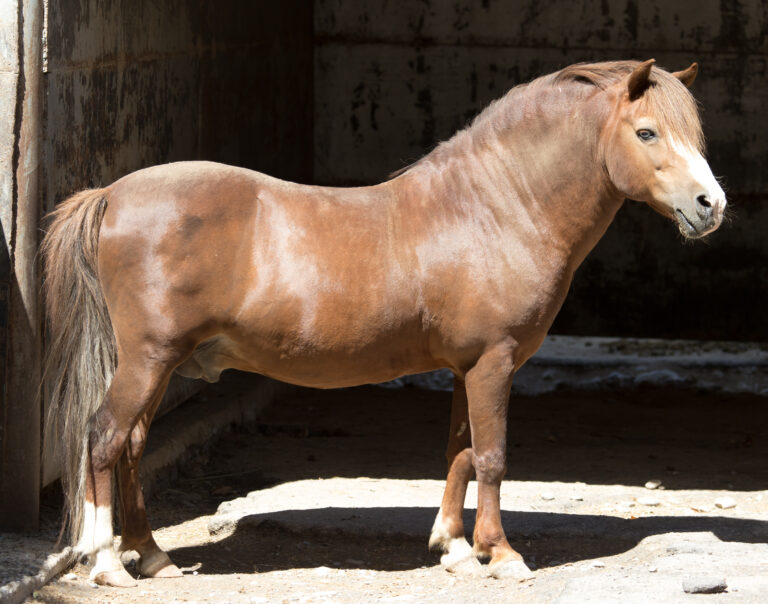
Rhiannon Fenton, DVM, CAC, CVA, CVFT, EqNBD, ACN had been treating an exhaustive and relentless fly bite dermatitis and secondary self-mutilation case with her own horse, Boo Boo, that had been difficult to resolve. Fenton’s daily mantra for Boo Boo was ‘Resist the Itch.’
The Veterinary Institute of Integrative Medicine describes inflammation relative to Fenton’s horse as “Equine dermatitis, a general term that covers inflammation of the horse’s skin. It can cause major discomfort to the animal; and in extreme cases, may lead to the equine mutilating itself in an effort to seek relief from itching (pruritus) by scratching or biting the inflamed skin. In extreme examples, the horse may lose hair and its inflamed skin may ooze fluids.”
Regarding a poem called The Art Of Healing, author W.H. Auden writes, “Healing, Papa would tell me, is not a science, but the intuitive art of wooing Nature.”
Certainly, healing people is not only the application of good treatment, but also hopefully the enlistment of the patient’s cooperation in achieving wellness. This is also true when a horse is the patient!
To that end, Fenton integrates Western and holistic medicine as well as emotional awareness in order to foster veterinary patient cooperation. “Some animals don’t know they aren’t helping the situation,” she says. “And for those horses that aren’t helping for whatever reason, they may be experiencing fear, anxiety, nervousness or many other unpleasant feelings, which will slow down healing time due to the stress of the situation and subsequent release of cortisol. Think about the horses with Cushing’s, insulin resistance, metabolic disease etc.—they can take longer to heal because of elevated cortisol in the blood stream. Cortisol suppresses the immune system, making healing time that much longer and can contribute to increased likelihood of infection. Cortisol also suppresses the production of collagen, a much-needed element in causing contraction of the wound and scab formation. We also don’t want elevation of cortisol because it will make the aforementioned metabolic diseases much worse or can actually be the inciting cause of such diseases.”
Therefore, it is imperative that we manage the patient’s stress and underlying disease states holistically in these situations.

Fenton has justifiable opposition to cortisol injections as a primary treatment for problematic skin conditions. “Unless the allergic response is so horrific that quality of life can only be returned by way of such an injection at the moment,” she may oblige, but insists that there must be simultaneous holistic medicine being used not only for the fly allergies and wound care, but to also offset the negative effects occurring to the internal organs—especially the entire endocrine system—when using steroid/cortisol injection(s).
“I have opted not to use cortisol injections in my own horse due to the vast amount of holistic and functional nutrition knowledge I have to successfully treat fly allergy dermatitis which traditional medicine doesn’t always recognize or accept,” she says.
Owners, veterinarians and caregivers can personally experience a plethora of frustrations given the fly-allergy-wound situation, much of which the horse can feel from us and become another factor that can slow down their healing. “It is important that we are mindful of our own emotional state while healing our animals,” adds Fenton. “Positive encouraging words, soothing voices and optimistic thoughts create a vibrational space for healing, decrease stress and the body’s physiological response to ramp up and release cortisol. To drive home the emphasis on maintaining our own positive emotional state further, even in the best-case scenario or ideal situations, healing is not always pleasant the entire way through for the horse, and we need to be patient, compassionate and preemptive!”
Explaining how unpleasant the healing process can be for the equine patient even in an ideal setting, Fenton offers these words of advice, “Within the proliferation phase of healing (beginning of scab formation), itching can become problematic and serve as an impediment to healing. As the wound stretches from the outer margins inward to make a closed wound, it has mechanical stress that causes itching. Similarly, when a fly lands on skin and causes a tickling sensation, it causes itching. The horse scratches when the wound is starting to close just as naturally as when a fly or any other skin irritant triggers it.”
Science now understands why it is so hard to ‘resist the itch’. The pain caused by scratching ‘an itch’ releases serotonin. “In the skin, serotonin can play a role inhibiting pain—and exacerbating it,” she says.
If your horse “scratches an itch, the pain causes the release of serotonin,” Fenton explains. “The serotonin causes pain relief, but then activates the 1A receptors, and then it’s time to itch.”
Serotonin is a pain modulator but also an “itch-sensation-activator.” So, it creates this vicious, repetitive cycle.
Some horses are naturally going to be more sensitive to itch or pain than others. Some will not care about the wound or a bandage and will stand there happy as a tree. Others might snort, be uncooperative and want to kick if there is pain, discomfort or distrust in the handling process (i.e., abused horses or those with previous traumatic experiences). In these situations, it is best to let a kind, compassionate veterinarian who is not in a rush provide instruction and guidance in person. It might require repeat visits from the professional.
Where Sox for Horses Fits In
Sox For Horses, Inc., also offers solutions for bandaging that will make it easier on the horse in pain.*
This what you can do to help your horse and be preemptive.
1) Cleaning the legs should be done gently using cool, clean water practicing “less is better.” Betadine, Chlorhexadine or other cleaning agents can help prevent and flush out infective agents initially, but they might exacerbate dermatitis when overused and not diluted. Fenton offers this advice: “Anti-itch herbal shampoos and conditioners can also help when used gently around the wound after initial injury if itching starts to be a problem.” Just make sure the area is dried well after shampooing. If a conditioner is used, make sure it is not left on longer than 1 minute and that it is thoroughly rinsed off.
2) Keep the wound dry and clean thereafter with appropriate bandaging. Fenton’s first choice for lower leg wounds are Silver Whinnys socks made by Sox For Horses, Inc. “They cover from the coronet band up to the knee or hock. They offer the antimicrobial properties of silver in the yarn to keep the Sox from serving as a petri dish for microorganisms that could infect the wound. Do NOT use generic socks you use for yourself. Those kind of people socks serve as a perfect substrate for growth of infectious organisms and have the potential to cause infection.”
3) When broad areas of tissue are raw and open, Fenton advises that a wound dressing with herbal anti-itch properties will help promote healing and can help prevent self-mutilation in the event that itching starts. “The wound dressing and a telfa pad can be applied underneath the Silver Whinnys for a few days; this is not meant to be an on-going thing as moisture from salves can slow down healing,” she says. Fenton recommends Dermo Paste or Healing Salve from Dr. Xie’s Jing Tang Herbal as a topical anti-itch, anti-fungal salve. (Note that a veterinarian has to prescribe these salves for owners.) This can be used for a few days to penetrate the tissues and stimulate healing. Thereafter, Sox For Horses, Inc. recommends that direct contact of their silver sox on the damaged skin is desirable to allow healing oxygen to reach the tissue. The Silver Whinnys will function to absorb the remaining exuding body serums and move them away from the tissue keeping the raw skin dry. There is more information regarding this issue on the Sox For Horses website.*
4) Cold compresses/ice leg wraps used short-term to numb the skin of itching can provide relief.
5) Topical numbing creams from your vet can be used if absolutely necessary.
6) Depending on the location of a wound, movement might need to be restricted so that tearing open of the wound does not occur such as when a leg is bent or flexed.
7) Bitter apple or chew repellant sprays can be applied on the outside of the Sox to deter the horse from chewing at the bandages.
8) Keep the flies AWAY! This is an extremely important part! As previously mentioned, the flies serve as that mechanical irritator that initiates itch and can also be a vehicle for disease transmission such as pigeon fever, bovine papilloma virus and others. This is another reason why Fenton likes Silver Whinnys Sox—they prevent flies from reaching the damaged, vulnerable and penetrable skin.
9) Keep in close contact with your veterinarian. If you see that the swelling is not dissipating, a fever develops, the wound is staying inflamed, red, oozing and hot instead of starting to shrink, flatten and dry up or your horse will just not leave the wound alone after exhausting steps 1-8, it is important to inform your vet so that the appropriate corrective measures can take place. Taking pictures every day is a great way to keep track of the progress and show your vet what is occurring. Video on camera phones is also highly encouraged as it can show depth perception a little better than a picture and the vet can get an idea of the degree of swelling or progress.
At this time Boo Boo is healed and remains protected by Silver Whinnys Sox. Fenton publishes her own blog discussing many topics of natural healing at http://www.vitalequine.us/blog.
You can contact Dr. Fenton at Vital Equine Holistic Veterinary Medicine; 310-800-1495; wellness@vitalequine.us; www.vitalequine.us.
Learn more about Silver Whinnys at soxforhorses.com
1. https://www.sciencenews.org/blog/scicurious/serotonin-lies-intersection-pain-and-itch
*Bandaging over Large Surface Wounds. Go to support, Sox Support, Article # 08
* Bandaging the Horse in Pain. https://soxforhorses.com/pdf/the-horse-in-pain-2018-08-06.pdf

![[Aggregator] Downloaded image for imported item #18216](https://s3.amazonaws.com/wp-s3-equimanagement.com/wp-content/uploads/2025/09/30141837/EDCC-Unbranded-8-scaled-1-768x512.jpeg)
![[Aggregator] Downloaded image for imported item #18711](https://s3.amazonaws.com/wp-s3-equimanagement.com/wp-content/uploads/2025/10/20105749/EDCC-Unbranded-14-scaled-1-768x512.jpeg)

